Thank you for coming along to the Press Club today – a forum which has played such an important role in chronicling the extraordinary economic times of the past year and a half.
And as we look back over that time, I think Australians have a right to be proud of what we have all achieved together.
We've passed through a period of global economic turmoil and emerged in better shape than any other advanced economy. At the beginning of the global crisis, we hardly dared to hope that the outcome for Australia might be this much stronger than virtually any comparable country.
The deep integration of our economy into global financial markets meant that we would very quickly feel the shocks we were seeing elsewhere in the world.
We certainly did feel the effects of the global recession. No doubt about it. Economic growth slowed, the unemployment rate drifted higher, and tax revenues quickly dried up to the tune of $170 billion. I feel very deeply for those people who lost a job during the crisis, even though they were ready and willing to work.
But things could have been a lot worse. A combination of community resilience and economic stimulus meant we avoided the levels of destruction and joblessness experienced elsewhere.
As Nobel laureate Paul Krugman said, high unemployment doesn't just punish the economy today, it punishes the future too.
For that reason, many other countries around the world might be tempted to contemplate the future with a sense of foreboding. They know they will have to wade forward knee-deep in high unemployment, massive debt, and a stuttering recovery.
Here, in contrast, we have a spring in our step. We maintained a Triple-A credit rating. Unemployment has a five in front of it. We grew while other economies contracted.
We're not without our own substantial challenges, but we're largely unencumbered by the kind of widespread hardships that the global recession has visited on most other advanced countries.
So as we contemplate the implications of the IGR I'm releasing today, we should start by reflecting on what we have to build upon. Think of where we have come from, what we have been through, and the confidence with which we confront the future detailed in this report.
Intergenerational Values
Some of these IGR numbers are, by now, familiar to you – we deliberately began a big national conversation on their consequences, over the past couple of weeks. So instead of running through every number in my prepared remarks today, I want to give you a bit more of the context underpinning the IGR.
When you're a baby boomer like me – and like many of you in this room – you never read a document with the year 2050 in it without some sober reflection on your own place (more likely, your lack of a place) in it.
The weekend before last, one of my daughters celebrated her 21st. We had a big bash with her friends and our family. It was great to catch up with her mates, hear about their plans, and get carried along by their optimism and enthusiasm.
These kids will be in their 50s and 60s when the forecast period of this IGR ends, along with a vast cohort of baby boomers' children. My son will be the age I am now. He'll be in a position to judge the success of the policies we put in place in the next few years.
As parents, we are all animated by the desire to pass on to our kids a better and more comfortable life than we had ourselves, but documents like this one remind us of our responsibility as a generation to pass on a better and stronger nation as well.
I often think of the past decisions that have made the biggest impact on our current quality of life – comparatively simple but profound ones like removing lead from petrol. More hard-fought ones like anti-sex discrimination and anti-racial discrimination legislation that have changed the face of our workplaces. Ones like universal health care and the far-sighted economic reforms over many years that have made us more competitive as a nation and more prosperous as a people.
And as I think of these past decisions, I also think of the decisions we make from now on, which will be as beneficial in 40 years time. Things like the CPRS, the Education Revolution, and health reform.
I'll have more to say about these a bit later on, but let me just say a few words about one set of challenges close to my heart.
We have made some strides as a nation in tackling poverty. Technology has played its part in this, but so has government policy, especially through the Age Pension and the family payment system.
But we still struggle to deal with the divisions in our society created by lack of opportunity – the way our nation has carved itself up into postcodes of advantage and disadvantage, too often incomprehensible to each other.
If there is one thing I hope my kids inherit from what we are currently doing as a government, it is a society defined by opportunity. That's why I'm most proud – in the time we have been in office – of the things that I know will contribute to this: a stronger pension system, better early childhood services, more investment in disadvantaged schools, a better health system.
It's true we can't entirely control how Australia will be different 40 years from now – just as we can't ultimately control how our kids turn out. But there is a great deal we can do to guide and shape how our country will be different 40 years from now, and extend to every Australian the opportunity to realistically choose the course of their own life, rather than having it chosen for them by birthplace or economic circumstance.
Ageing Population
Big challenges lie ahead and the Intergenerational Report tells us in really compelling terms why these matter so much to the future we seek.
One of those challenges is an ageing population.
Consider two simple facts. Between now and 2050:
- The number of people aged 65 to 84 years will more than double; and
- The number of people aged 85 and over will more than quadruple.
So by 2050, nearly one-quarter of Australia's population will be aged 65 and over, compared with 13 per cent today. This means that there will be only 2.7 people of working age for every person aged 65 and over, compared with 5 people today.
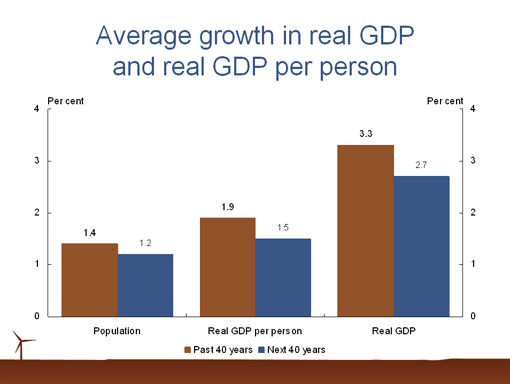
We don't expect living standards to shrink, but we do expect them to grow more slowly than they have done in the past. Real GDP per person is projected to grow at 1.5 per cent annually over the next 40 years, compared with 1.9 per cent over the past 40 years.
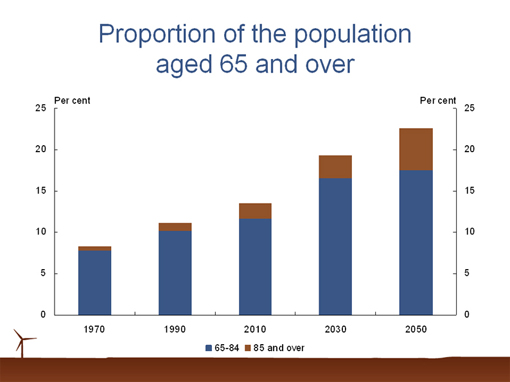
At the same time, our fiscal position will deteriorate as underlying structural pressures that have been built into the budget over a number of years are magnified by the effects of an ageing population.
Left unchecked, these pressures would push government spending up from the middle of this decade by about 4¾ percentage points to around 27 per cent of GDP by 2050. And by 2050, spending would exceed revenues by about 2¾ per cent of GDP – that's what economists call the fiscal gap.
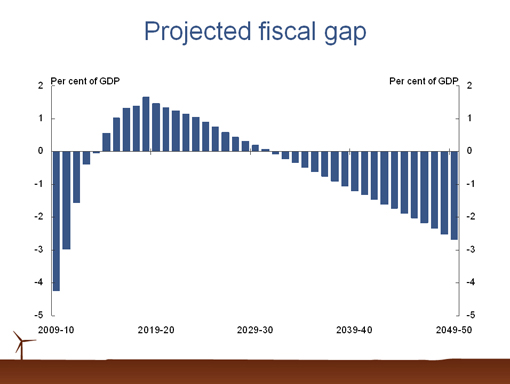
Faced with these pressures, we need to ensure our budget is sustainable, or the quality of government services and public infrastructure will suffer.
Unfortunately, in the period of strong economic growth in the 2000s, the Commonwealth's real spending increased by an average of 3.8 per cent a year, significantly faster than in previous periods of strong growth in the 1980s and 1990s.
This was funded from a tax windfall delivered by the commodity boom, much of which has been stripped away during the current global downturn.
The lesson here is obvious: we can't just set our budget position only for the good times; it needs to be robust enough to deal with more difficult circumstances as well. And it needs to be cognisant of the other big challenges out there, including some very big ones like climate change and health reform, and the need to lift productivity so we can grow the economy.
Productivity
Faced with these budget challenges, we essentially have three options. We can cut government services or increase taxes; we can allow budget pressures to build and leave the problem for future generations to deal with; or we can take steps now to grow our economy.
By growing the economy we increase our capacity to meet the fiscal costs of ageing, without increasing the overall tax burden on working Australians.
And the best way to grow the economy is to maintain our focus on productivity, on investing in skills and infrastructure – nation building, the Education Revolution and regulatory and tax reform to underpin productivity growth in the decades to come.
This is the core of our response to the intergenerational challenges laid bare in the document I release today – and in the last two years we've taken some big strides already.
Building productivity, of course, is not just a challenge for government. Ultimately, it is Australian workers and businesses that will deliver the higher productivity – by skilling themselves up, tooling up, and working smarter.
Many of you here will be aware that Australia's productivity growth over the past decade has slowed considerably. Average annual labour productivity growth has fallen from 2.1 per cent in the 1990s, to around 1.4 per cent in the 2000s. This won't be good enough for an ageing population like ours.
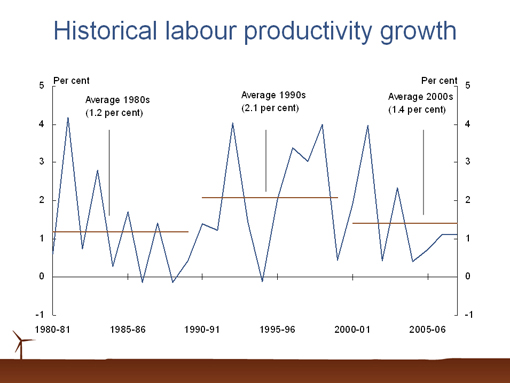
If Australia's productivity growth rate could be increased, our economy would be bigger, living standards would be higher, and the fiscal pressure from ageing would be reduced.
That's why you would have heard the Prime Minister focus on this simple fact: if we were to boost productivity growth from an average of 1.6 per cent to 2 per cent a year, and sustain this over the next 40 years, real GDP per person would be around 15 per cent higher. That's equivalent to raising living standards by $16,000 a year in today's dollars by 2050, for every man, woman and child in Australia.
This won't be easy but with the right investment and effort it can be achieved over time.
Participation
On top of this push for productivity we need to keep encouraging workforce participation.
Obviously the Government doesn't mandate where people work or how many hours they work in a week, nor would we ever want to. But what we can do is make sure that people who can work have every opportunity to participate in a meaningful way in the economy.
That's what our childcare and tax reforms have been all about. And why we're so focused on building up our economy's human capital.
As the workforce becomes a smaller proportion of our society, we simply can't afford to waste the potential of our future generations. Nor can we afford to waste the potential of older Australians.
There has been a tendency in previous reports to present the ageing of the population only as a problem to be solved.
I prefer to focus on how we can best harness the life experiences and intellectual capital of older Australians. These are Australians who have already made a massive contribution to our nation. Their experience is invaluable.
Many will choose to leave the workforce, and enjoy a well-earned retirement, for a variety of reasons. But if they want to work they should be welcomed into the workforce.
Australia has a lower rate of mature age participation than other comparable countries – like the US, UK, Canada and New Zealand. There is considerable room for improvement in this area.
Groups like National Seniors Australia – and it's good to see Everald Compton here today – have identified a range of issues that we need to consider – including raising community awareness, encouraging skills development and promoting healthy workplaces.
If we can remove the obstacles for older Australians who want to work, we not only improve the quality of their life but we also strengthen the economy. That's what our Budget changes to the work bonus were all about.
The choice for older Australians to stay in or leave the workforce should be just that – a choice, not something forced on them by prejudice or bad policy.
That's why I am announcing today, a $43 million package of practical measures to further support mature age participation.
This includes programs targeted at retraining and reskilling. It includes initiatives to support older Australians who are at risk of losing their job due to a health condition, injury or disability. And it also includes enhanced assistance through the Keep Australia Working Career Advice Line.
We will also establish a Consultative Forum to foster attitudinal change, conduct research and advise Government on mature age participation issues. The Forum will play a key role in the development of the Government's forward agenda on this really critical issue. I am very pleased that Everald has agreed to Chair it.
The tax and transfer system is another key area that affects participation and I'll have more to say on this when I respond to the report from the independent tax review.
Population Pressures
Having covered the productivity and participation challenges I want to say a few things about the third P; population.
The IGR projects higher population growth than was previously expected, mostly because of changed assumptions about fertility and net overseas migration.
The total fertility rate is projected to average 1.9 births per woman, rather than falling to 1.7 as projected in IGR 2007.
And the level of net overseas migration is expected to average 180,000 per year, rather than the adjusted level of 140,000 that would have been projected in IGR 2007 if it were based on current ABS methodology. Or another way of putting it, we now project that the net overseas migration rate will average 0.6 per cent of the resident population annually, equivalent to the experience over the last 40 years.
Now, while some considerable thought is put into these projections, it is important to keep in mind that these numbers are not carved in stone. And they are not targets.
If these average projections were to eventuate, Australia would have 36 million people in 2050, up from 22 million today.
To some extent, this higher population growth would help us manage the challenges of an ageing population.
But there's no doubt rising population will place pressures on us as well – on our roads, schools and hospitals, on our environment, and on our communities.
We can manage these pressures if we start planning for them now.
For example, we have committed more than $4.6 billion as part of the 2009-10 Budget to fund urban passenger rail infrastructure, as part of a massive investment in transport infrastructure more generally. This is a down payment on Australia's infrastructure needs of tomorrow, and it complements the Prime Minister's strategy for the first ever national criteria for the sustainable planning of our major cities.
The main point I want to make here is that, whether we are talking about population growth or economic growth, we're not interested in achieving growth for its own sake.
We are looking for growth that will support an improved quality of life over time. Growth that improves our standard of living and at the same time improves our social cohesion and protects our environment.
That's why we are spending so much time on the Education Revolution, health reform, water reform, and the Carbon Pollution Reduction Scheme.
Because the answer isn't to stop growing, but to grow differently. To grow sustainably.
Climate Change
Of course, you can't talk about sustainability without also coming to terms with the risks posed by dangerous climate change.
Our approach is based on the scientific consensus from the Bureau of Meteorology, the CSIRO, and the worldwide experts in the IPCC.
The IGR highlights that market‑based mechanisms such as the CPRS are the most effective, least costly way to tackle climate change. That's why 32 countries are already operating emissions trading schemes, and other countries like the United States, Japan and Korea are looking at introducing one.
The CPRS makes polluters pay. It will be a game changer that will gradually transform our whole economy – encouraging all industries and jobs to become greener over the IGR period. For instance, it will allow us to cut the emission intensity of motor vehicle manufacturing by over 75 per cent and replace substantial amounts of coal-fired power generation with renewable sources.
As the report explains, a market‑based mechanism is the best and least-cost path to a low-pollution economy because it allows the market to decide how best to reduce emissions, rather than putting these decisions in the hands of bureaucrats.
In contrast, the red tape scheme Mr Abbott will release tomorrow will weigh down the economy.
Attempting to achieve large-scale emissions reductions primarily through regulatory and subsidy arrangements would be costly for the economy and businesses. And it would not provide any support for households whatsoever.
Mr Abbott has signed up to our target – but his plan has no cap on emissions to deliver them and no way to pay for them credibly.
He must announce a fully-costed, fully-funded policy or admit that his climate change policy is a phoney magic pudding policy, and that he can't be trusted on climate change.
Fiscal Sustainability
The final challenge I want to touch on this afternoon overlays all the others. Because ultimately, of course, the conclusions in this IGR present big challenges for the federal budget.
The ageing of our population, the growth in demand for health and other services that creates, and the infrastructure, social and environmental investments also required, means extra fiscal discipline will be needed to keep the budget in a strong position.
The Government has already committed itself to a fiscal strategy that will improve the sustainability of government finances over the medium-term. Fully implemented, our fiscal strategy will deliver a permanent improvement in spending of around 1 per cent of GDP and put the budget on a more sustainable footing.
This will mean difficult decisions. Government spending that seemed affordable during the period of largesse prior to the global crisis may not be affordable over the longer term.
It is up to us to take the decisions that ensure our spending is affordable over the longer term. And we have already begun this task.
We have introduced reforms to improve the sustainability of the Age Pension and family payment systems, and means-test the Private Health Insurance Rebate – this last one held up by a Liberal Party who believes teachers and nurses should be subsidising the private health insurance of people like me.
All up, these reforms result in a cumulative reduction in spending of $275 billion in today's dollars, by 2049-50. With reforms to the Private Health Insurance Rebate alone, accounting for $100 billion of this amount.
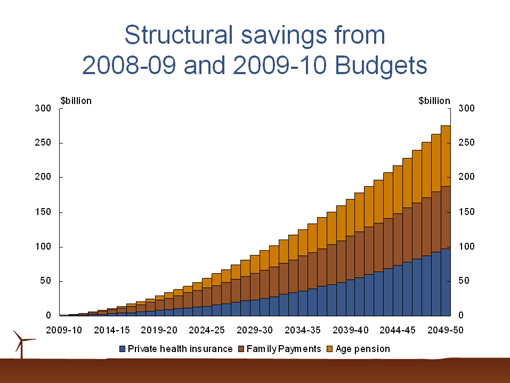
Conclusion
This IGR is a stark reminder that we can't sit on our hands or play political games with this country's future.
Passing all of these tests I've outlined today will be extremely difficult, but not beyond us.
To those daunted by the challenges I've laid out today, I say surely a nation that defied global economic gravity in recent times is capable of countering the effects of an ageing population and the threat of climate change.
In every area – in fiscal sustainability, in participation and productivity, in cities and infrastructure, in climate change – the lesson is that if we act today then we reap the benefits in the future.
We owe it to ourselves and to our children to take reasonable action to avoid the sharp and disruptive adjustments that would be necessary if we did what my predecessor used to do, which was release an IGR then quickly forget its message, and neglect to take any action on its findings.
In 40 years time, I want it said ours was a generation marked by foresight and decisiveness.
I want it said that the national unity and purpose that carried us through the global financial crisis was harnessed to lock in something more enduring.
I want it said of us that we built together sustainable growth despite headwinds that are just as strong, or stronger than those that we experienced in 2008 and 2009.
And I want it said, by my kids and yours, that we refused to postpone the challenges we knew were coming. That we built a country that wasn't just older, but wiser. A country that wasn't just wealthier, but fairer and more sustainable. And a country not just bigger, but better as well.
Thank you.
